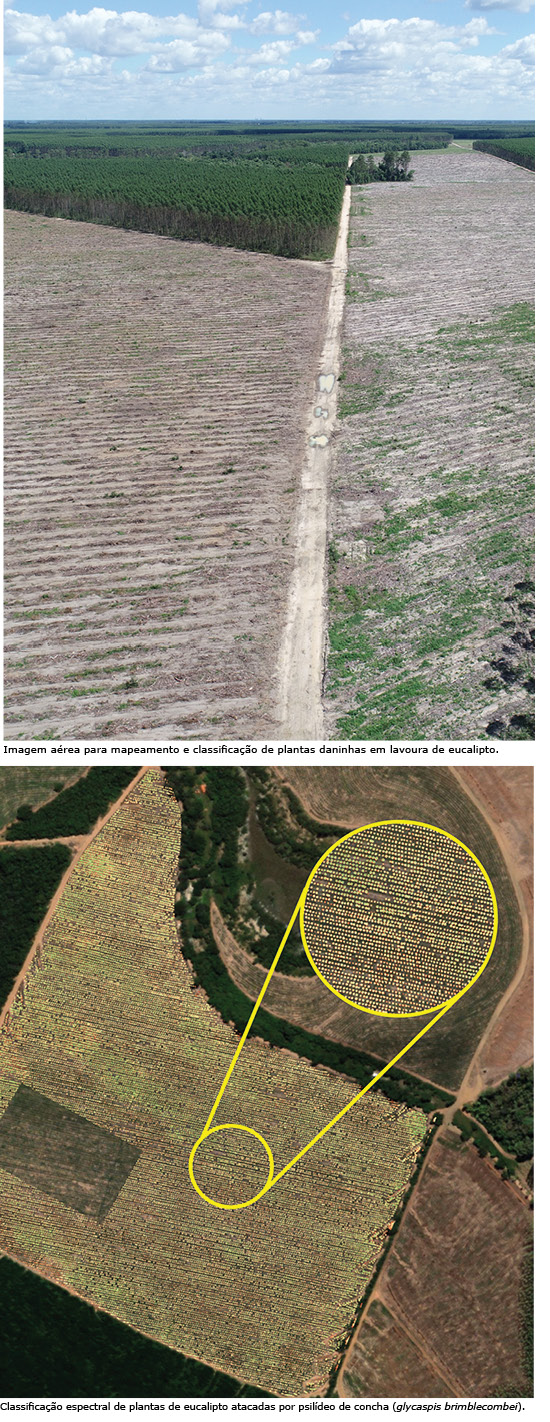Samuel de Assis Silva
Professor de Mecanização Agrícola da UF do Espírito Santo
OpCP75
Inteligência artificial na silvicultura
O que somos atualmente como civilização é resultado de um processo temporalmente longo e que engloba, dentre outros fatores, transformações evolutivas, pluralidade cultural e comportamental, capacidade adaptativa, descobertas científicas, e desenvolvimento tecnológico. Ao longo de séculos, a sociedade foi se adaptando a diferentes cenários, condições e, principalmente, transformando o mundo ao seu redor, de modo a criar as condições necessárias para a sua existência e perpetuação. Essa capacidade inventiva do homem é, talvez, a responsável pela sobrevivência e prosperidade de nossa espécie, conforme apontam alguns estudos mais recentes.
 Em um contexto de evolução contínua, as transformações, ora lentas, ora mais aceleradas, foram moldando lentamente a sociedade que somos hoje. Nessa linha do tempo, alguns marcos como a descoberta do fogo, a domesticação das plantas, a invenção da roda, as descobertas de algumas leis da natureza e a revolução industrial, por exemplo, representaram saltos vertiginosos neste processo. Talvez, o mais recente salto seja o desenvolvimento das tecnologias de informação, trazendo consigo um encadeamento de processos evolutivos, os quais estão separados, não mais por séculos, mas por poucas décadas ou anos.
Em um contexto de evolução contínua, as transformações, ora lentas, ora mais aceleradas, foram moldando lentamente a sociedade que somos hoje. Nessa linha do tempo, alguns marcos como a descoberta do fogo, a domesticação das plantas, a invenção da roda, as descobertas de algumas leis da natureza e a revolução industrial, por exemplo, representaram saltos vertiginosos neste processo. Talvez, o mais recente salto seja o desenvolvimento das tecnologias de informação, trazendo consigo um encadeamento de processos evolutivos, os quais estão separados, não mais por séculos, mas por poucas décadas ou anos.
 Em um contexto de evolução contínua, as transformações, ora lentas, ora mais aceleradas, foram moldando lentamente a sociedade que somos hoje. Nessa linha do tempo, alguns marcos como a descoberta do fogo, a domesticação das plantas, a invenção da roda, as descobertas de algumas leis da natureza e a revolução industrial, por exemplo, representaram saltos vertiginosos neste processo. Talvez, o mais recente salto seja o desenvolvimento das tecnologias de informação, trazendo consigo um encadeamento de processos evolutivos, os quais estão separados, não mais por séculos, mas por poucas décadas ou anos.
Em um contexto de evolução contínua, as transformações, ora lentas, ora mais aceleradas, foram moldando lentamente a sociedade que somos hoje. Nessa linha do tempo, alguns marcos como a descoberta do fogo, a domesticação das plantas, a invenção da roda, as descobertas de algumas leis da natureza e a revolução industrial, por exemplo, representaram saltos vertiginosos neste processo. Talvez, o mais recente salto seja o desenvolvimento das tecnologias de informação, trazendo consigo um encadeamento de processos evolutivos, os quais estão separados, não mais por séculos, mas por poucas décadas ou anos.A Inteligência Artificial (IA) é parte dessa era das tecnologias e tem causado uma revolução na forma como lidamos com o meio que nos circunda e como executamos tarefas com diferentes níveis de complexidade. O surgimento da IA remonta aos primeiros anos da década de 1940, quando Warren McCulloch e Walter Pitts (cientistas norte-americanos) publicaram um artigo científico relatando a criação de um modelo matemático para um neurônio artificial, baseado no funcionamento do neurônio humano.
Dos anos 1940 até os dias atuais, avanços foram obtidos na tentativa de construir sistemas artificiais capazes de simular e, até mesmo, substituir o raciocínio humano. As áreas do conhecimento que mais se beneficiaram com tais avanços são a industrial e a comunicação. Na silvicultura, por sua vez, as transformações promovidas pelas tecnologias de informação são mais recentes e ainda discretas.
Apesar de um uso ainda discreto, as ferramentas de IA têm promovido uma revolução nos campos de produção. Pela sua inserção em diversas operações silviculturais, a IA pode elevar ainda mais a produtividade das florestas plantadas, auxiliando no enfrentamento do desafio atual de atender as demandas mundiais dos próximos anos. Dados recentes da FAO apontam para uma demanda de 3,1 bilhões de m³ de madeira no ano 2050, o que representa um crescimento de mais de 35% em relação à atual.
Definida como a capacidade de dispositivos, sistemas e máquinas em simular e reproduzirem o raciocínio humano, a IA retira a subjetividade dos processos e permite o tratamento simultâneo de um grande volume de dados, aprendendo e definindo padrões a partir de uma quantidade massiva de informações.
A IA acelera as interpretações dos fenômenos naturais e, mais importante, as tomadas de decisão. Na silvicultura, a IA pode ser percebida nos sistemas autônomos de máquinas, nos sensores destinados a obter remotamente informações acerca dos cultivos, nos controladores que, de forma automatizada, tomam decisões e fazem intervenções em tempo real.
Além das aplicações acima descritas, outras tantas têm sido desenvolvidas. A grande quantidade dessas soluções baseadas em IA advém de modelos de aprendizagem de máquina (machine learning), seja ela profunda (deep learning) ou não. Partindo-se desses princípios, sistemas capazes de aprender padrões e classificar e/ou prever fenômenos inerentes à produção florestal, fornecem informações
rápidas e confiáveis culminando na maior eficiência no uso de insumos gerais, otimização ou substituição da mão-de-obra humana e maior eficácia nas práticas de manejo. O uso de algoritmos de aprendizado de máquina segue um processo sequencial que se inicia com a construção de padrões e termina com a avaliação da acurácia e da precisão dos modelos.
No que diz respeito aos modelos utilizados, estes podem ser agrupados naqueles de classificação e de regressão. A finalidade de cada um indica a sua aplicabilidade, sendo os de classificação destinados a identificação de feições e/ou fenômenos em um universo amostral, enquanto os de regressão são destinados à previsão destes padrões e/ou destes fenômenos. Diversos algoritmos são destinados às duas funções, mudando apenas a forma como eles são aplicados. Um exemplo desses algoritmos “polivalentes” são as redes neurais artificiais (RNA), sejam elas simples ou de multicamadas.
Utilizando RNA, desenvolvemos uma solução computacional para predição da rebrota de eucalipto após a aplicação de herbicidas. A solução classifica a resposta espectral das brotações e as compara com os padrões definidos no aprendizado, identificando as variações que são sugestivas de uma rebrota e prevendo quando e onde ela acontecerá.
Outro algoritmo de IA muito utilizado na silvicultura é o Random Forest. Quando em associação com imagens de alta resolução espacial, obtidas com sensores orbitais ou aéreos, esse algoritmo permite a identificação e segmentação de alvos em um ambiente de complexidade como uma área de produção florestal. Com esse algoritmo desenvolvemos um sistema para identificação de plantas daninhas em área de produção de eucalipto. O referido sistema tem precisão superior a 90% na classificação das plantas daninhas e definição dos níveis de infestação e superior a 80% na segmentação das plantas de acordo com sua morfologia foliar, separando-as em “folha larga” e “folha estreita”.
Entrando no ambiente do aprendizado profundo, a complexidade é substancialmente superior, entretanto, com possibilidades de uso e aplicação igualmente superiores. Com modelos desta classe, é possível, por exemplo, a modelagem de árvores em sistemas de cultivo e a contagem de plantas e falhas de plantio.
A contagem de plantas é uma demanda da silvicultura, pois é impensável que essa operação seja realizada de forma manual. Contar plantas é imprescindível para o estabelecimento preciso, por exemplo, do índice de sobrevivência em talhões após o transplantio das mudas.
A implementação da IA na silvicultura é uma jornada contínua, uma vez que, com a revolução digital, os modelos e sistemas são dinâmicos, com atualizações e evoluções periódicas. A capacidade das empresas do setor florestal de compreender a importância da IA e, ainda mais, de identificar o posicionamento dela nas diferentes etapas silviculturais determinará o curso da transformação que o setor vivenciará.
Num cenário de crescente escassez de recursos naturais, o uso de tecnologia é uma saída viável para conciliar produtividade e sustentabilidade. O processo evolutivo do nosso tempo nos conduzirá para um cenário irreversível de digitalização, com maior conectividade, com algoritmos cada vez mais sofisticados e máquinas inteligentes. A carência de aperfeiçoamento, de escalonamento e, principalmente, de detalhamento, imporá uma nova ordem, ditada pela digitalização e perpassando pelo uso de IA.




